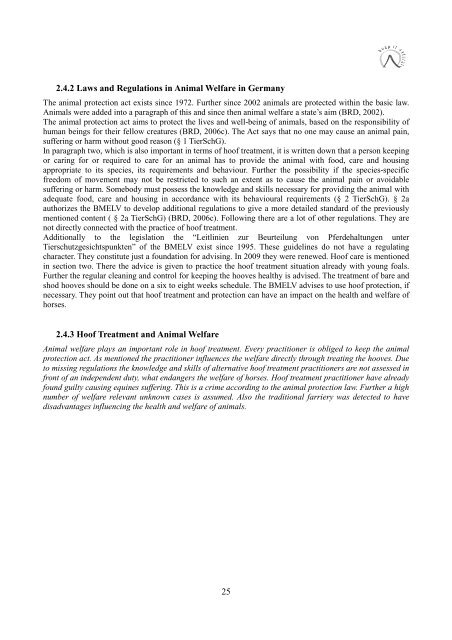Bachelor Thesis - Christina Kuenen - Hufpfleger
Bachelor Thesis - Christina Kuenen - Hufpfleger
Bachelor Thesis - Christina Kuenen - Hufpfleger
You also want an ePaper? Increase the reach of your titles
YUMPU automatically turns print PDFs into web optimized ePapers that Google loves.
2.4.2 Laws and Regulations in Animal Welfare in Germany<br />
The animal protection act exists since 1972. Further since 2002 animals are protected within the basic law.<br />
Animals were added into a paragraph of this and since then animal welfare a state’s aim (BRD, 2002).<br />
The animal protection act aims to protect the lives and well-being of animals, based on the responsibility of<br />
human beings for their fellow creatures (BRD, 2006c). The Act says that no one may cause an animal pain,<br />
suffering or harm without good reason (§ 1 TierSchG).<br />
In paragraph two, which is also important in terms of hoof treatment, it is written down that a person keeping<br />
or caring for or required to care for an animal has to provide the animal with food, care and housing<br />
appropriate to its species, its requirements and behaviour. Further the possibility if the species-specific<br />
freedom of movement may not be restricted to such an extent as to cause the animal pain or avoidable<br />
suffering or harm. Somebody must possess the knowledge and skills necessary for providing the animal with<br />
adequate food, care and housing in accordance with its behavioural requirements (§ 2 TierSchG). § 2a<br />
authorizes the BMELV to develop additional regulations to give a more detailed standard of the previously<br />
mentioned content ( § 2a TierSchG) (BRD, 2006c). Following there are a lot of other regulations. They are<br />
not directly connected with the practice of hoof treatment.<br />
Additionally to the legislation the “Leitlinien zur Beurteilung von Pferdehaltungen unter<br />
Tierschutzgesichtspunkten” of the BMELV exist since 1995. These guidelines do not have a regulating<br />
character. They constitute just a foundation for advising. In 2009 they were renewed. Hoof care is mentioned<br />
in section two. There the advice is given to practice the hoof treatment situation already with young foals.<br />
Further the regular cleaning and control for keeping the hooves healthy is advised. The treatment of bare and<br />
shod hooves should be done on a six to eight weeks schedule. The BMELV advises to use hoof protection, if<br />
necessary. They point out that hoof treatment and protection can have an impact on the health and welfare of<br />
horses.<br />
2.4.3 Hoof Treatment and Animal Welfare<br />
Animal welfare plays an important role in hoof treatment. Every practitioner is obliged to keep the animal<br />
protection act. As mentioned the practitioner influences the welfare directly through treating the hooves. Due<br />
to missing regulations the knowledge and skills of alternative hoof treatment practitioners are not assessed in<br />
front of an independent duty, what endangers the welfare of horses. Hoof treatment practitioner have already<br />
found guilty causing equines suffering. This is a crime according to the animal protection law. Further a high<br />
number of welfare relevant unknown cases is assumed. Also the traditional farriery was detected to have<br />
disadvantages influencing the health and welfare of animals.<br />
25


